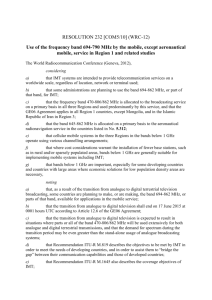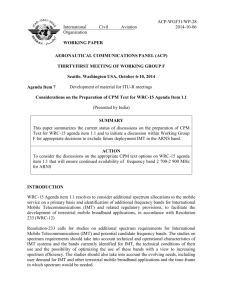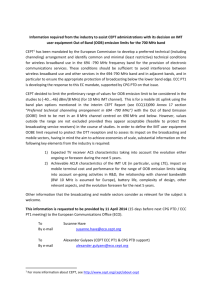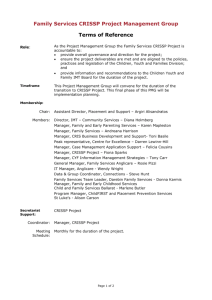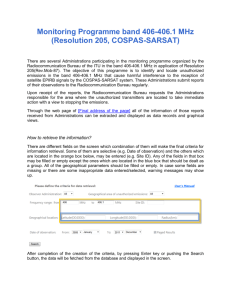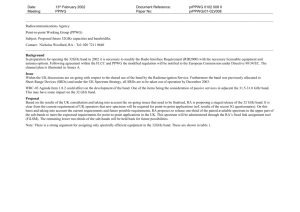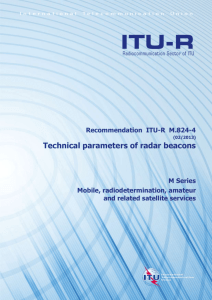1 Introduction - Региональное содружество в области связи
advertisement
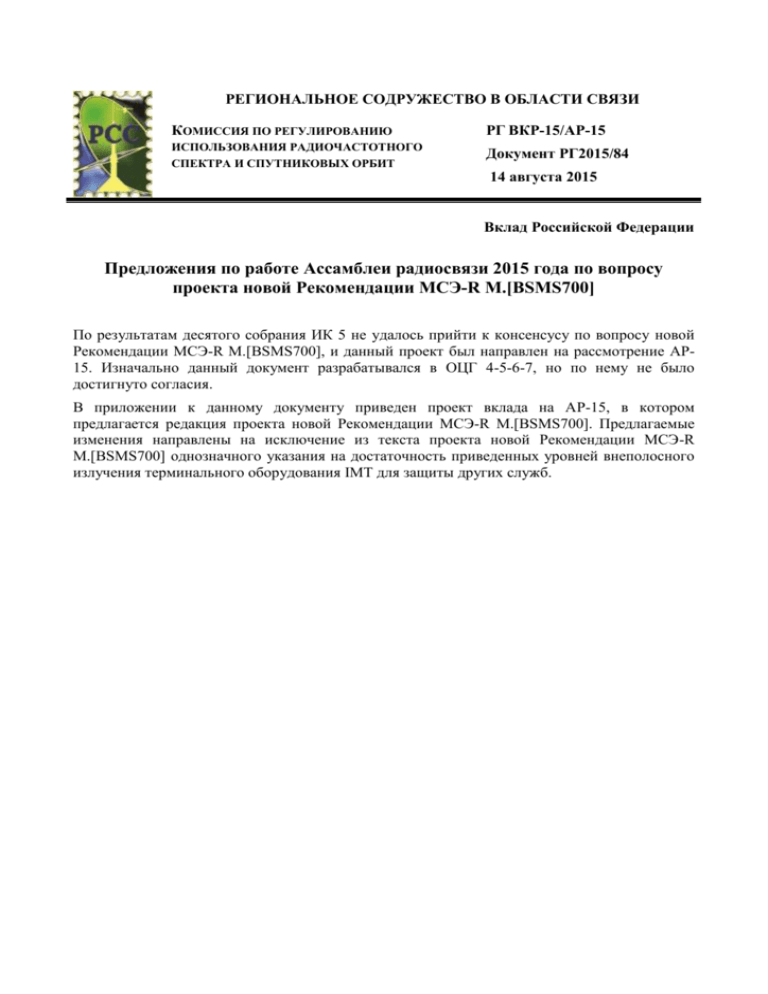
РЕГИОНАЛЬНОЕ СОДРУЖЕСТВО В ОБЛАСТИ СВЯЗИ КОМИССИЯ ПО РЕГУЛИРОВАНИЮ РГ ВКР-15/АР-15 ИСПОЛЬЗОВАНИЯ РАДИОЧАСТОТНОГО СПЕКТРА И СПУТНИКОВЫХ ОРБИТ Документ РГ2015/84 14 августа 2015 Вклад Российской Федерации Предложения по работе Ассамблеи радиосвязи 2015 года по вопросу проекта новой Рекомендации МСЭ-R M.[BSMS700] По результатам десятого собрания ИК 5 не удалось прийти к консенсусу по вопросу новой Рекомендации МСЭ-R M.[BSMS700], и данный проект был направлен на рассмотрение АР15. Изначально данный документ разрабатывался в ОЦГ 4-5-6-7, но по нему не было достигнуто согласия. В приложении к данному документу приведен проект вклада на АР-15, в котором предлагается редакция проекта новой Рекомендации МСЭ-R M.[BSMS700]. Предлагаемые изменения направлены на исключение из текста проекта новой Рекомендации МСЭ-R M.[BSMS700] однозначного указания на достаточность приведенных уровней внеполосного излучения терминального оборудования IMT для защиты других служб. 2 RA15/-E Radiocommunication Assembly (RA-15) Geneva, 26-30 October 2015 INTERNATIONAL TELECOMMUNICATION UNION Document RA15/-E xx 2015 Original: English [TBD] PROPOSED WAY FORWARD IN RELATION TO THE DRAFT NEW RECOMMENDATION ITU-R M.[BSMS700] 1 Introduction During its 10th meeting, SG 5 has considered the draft new Recommendation ITU-R M.[BSMS700]. However, SG 5 and SG 6 haven’t reached agreement on the draft new Recommendation ITU-R M.[BSMS700] and it was decided to forward the consideration of this document to Radiocommunication Assembly 2015. The concern expressed by some administrations is linked to a number of technical inconsistences throughout the document, which haven’t been addressed since the preparation of the document at the last JTG 4-5-6-7 meeting. 2 Discussion In the recommends part of the new proposed Recommendation ITU-R M.[BSMS700] two levels of outof-band emissions ( “unwanted emissions”, to be more precise) from IMT mobile terminals in the frequency band below 694 MHz for the protection of exiting services are proposed. However, these two levels proposed in the draft Recommendation do not fully address protection of existing services, having allocations below 694 MHz and do not provide univocal “guidance to administrations on specific outof-band emission (OOBE) level of IMT mobile stations operating in the frequency band 694-790 MHz” as it is supposed. The content of this draft is not in consistency with the title and the scope, which claim that the purpose is “protection of existing services in Region 1 in the frequency band below 694 MHz”. Moreover recommends 1 and 2 of this draft Recommendation contradict each other providing different levels to protect systems of existing services without explaining how it relates to the protection of other services or interference potential into receivers. From technical point of view, the IMT channel bandwidth in 703-733 MHz frequency band have no relevance to unwanted emissions limit in frequency bands below 694 MHz, required to protect other services. It also should be mentioned that ITU-R studies with respect to protection of other services below 694 MHz are not completed and relevant Report is not agreed neither by JTG 4-5-6-7 nor by SG 5 and SG 6. In recommends 1 and 2 out-of-band emissions of IMT mobile stations operating above 703 MHz are defined for the frequencies below 694 MHz. Such definition of out-of-band emissions 3 RA15/-E contradicts the definition in RR No 1.144 (1.144 out-of-band emission*: Emission on a frequency or frequencies immediately outside the necessary bandwidth which results from the modulation process, but excluding spurious emissions) which presumes out-of-band emissions starting at the channel edge, for example at 703 MHz. Consequently it is recommended that this part as well as other parts of the draft new Recommendation ITU-R M.[BSMS700] should be redrafted to bring terms used in the text in line with RR. From the text of the draft new Recommendation ITU-R M.[BSMS700] it is impossible to derive for which services the protection has been recommended, even though the proposed values have been originally considered within JTG 4-5-6-7 only for broadcasting service. Further studies are required to address the protection of different services having allocations in the frequency band below 694 MHz if Recommendation’s scope is to consider several services. According to §6.1.2 NOTE 3 of Resolution ITU-R 1-6 “Study Groups developing Recommendations that include sharing criteria for radiocommunication services must obtain agreement, prior to their adoption, of the Study Groups responsible for those services”. These further studies must be carried out in close collaboration with the relevant Study Groups/Working Parties. For broadcasting service it is necessary to further and properly address the protection of broadcasting stations in close collaboration with WP 6A and SG 6 to resolve all missing elements. Furthermore, the draft new Recommendation ITU-R M.[BSMS700] does not provide any additional type of information on unwanted emissions comparing with Recommendation ITU-R M.2071 on generic unwanted emission characteristics of mobile stations using the terrestrial radio interfaces of IMT-Advanced. Moreover, Recommendation ITU-R M.2071 is being developed in more detailed and constructive manner involving consultation with relevant standardization organizations. Having two ITU-R Recommendations providing guidance on the same issues may lead to duplication and may create inconsistencies between them in the future. 3 Proposal It is the view of the RCC Administrations that the draft new Recommendation ITU-R M.[BSMS700] provided by SG 5 can not be considered as the guidance for administrations and should not be adopted and approved by RA-15 in its current version. Approval of the document with such number of technical inconsistances undermines the credibility of ITU-R in technical expertise. It should be noted that the most straightforward way to address unwanted emission of IMT mobile stations in the band 694-790 MHz is through the traditional update of Recommendation ITU-R M.2071. Furthermore, the revision of Recommendation ITU-R M.2071 is already started and planned to be completed by WP 5D in June 2016. According to the information from external standardisation organizations this revision will include the very same levels of unwanted emissions for IMT mobile stations as those proposed in the draft new Recommendation ITU-R M.[BSMS700]. In case of further consideration of the the draft new Recommendation ITU-R M.[BSMS700] at RA-15, the RCC Administrations deem necessary to make modifications to the text of the Recommendation in the way as described in the Attachment to this contribution. 4 RA15/-E ATTACHMENT DRAFT NEW RECOMMENDATION ITU-R M.[BSMS700] Specific unwanted emission limit of IMT mobile stations operating in the frequency band 694-790 MHz in Region 1 in the frequency band 470-694 MHz Scope This Recommendation provides guidance to administrations on specific unwanted emissions limit of IMT mobile stations operating in the frequency band 694-790 MHz for the frequency band 470-694 MHz in Region 1 in order to facilitate coexistence with broadcasting service in this band. The ITU Radiocommunication Assembly, considering a) that Recommendations ITU-R M.1581 and ITU-R M.2071 specify the generic unwanted emission characteristics of IMT-2000 and IMT Advanced mobile stations, respectively; b) that Recommendation ITU-R M.1036 provides the frequency arrangements of IMT networks, including those to be used in the band 694-790 MHz; c) that Resolution 232 (WRC-12) contains provisions on the use of the frequency band 694 – 790 MHz by the mobile, except aeronautical mobile, service in Region 1; d) that the unwanted emissions in the band 470-694 MHz of IMT mobile stations operating in Region 1 in the frequency band 694-790 MHz need to be limited in order to facilitate coexistence with broadcasting service below 694 MHz; e) that too stringent limits may lead to an increase in size, cost or in complexity of IMT radio equipment; f) the need to facilitate global harmonisation and circulation of equipment to promote economies of scale; g) that administrations decide on the channel bandwidth which is to be used by the user equipment; h) that in some countries of Region 1 the deployment of IMT systems in the 700 MHz band is expected to start immediately after WRC-15; i) that in the band 470-694 MHz in Region 1 stations of broadcasting service have been extensively deployed and the development of broadcasting service will be continued, recognizing a) that a limit on the unwanted emissions from IMT mobile stations is only one of the factors necessary to facilitate compatibility with broadcasting service in the band 470-694 MHz; b) that different unwanted emissions limits for IMT mobile stations operating in the 694790 MHz band have been considered by Region 1 administrations; 5 RA15/-E c) that adoption of more stringent unwanted emissions limit from IMT mobile stations in the band 470 -694 MHz could help to limit the interference potential into broadcasting service operating in frequency band 470-694 MHz; d) that the IMT mobile station unwanted emissions limits should be technically feasible from the point of view of practical implementation of IMT mobile stations and help to achieve global harmonisation; noting a) that the lower duplexer of A5 channelling arrangement in Recommendation ITU-R M.1036 (i.e. uplink in 703-733 MHz) and a maximum output power of 23 dBm; b) that an unwanted emissions limit of -26.2 dBm/6MHz for an IMT mobile station using the A5 channelling arrangement is included in the relevant 3GPP specification; c) that new relevant 3GPP specifications contain an unwanted emissions limit of -25 dBm/8 MHz for up to 20 MHz IMT channel bandwidth and a value of -42 dBm/8MHz for 10 MHz IMT channel bandwidth; d) that existing mobile devices not complying with the unwanted emissions limit referred to in recommends 2 might continue to be deployed; e) that based on studies conducted in ITU-R in response to Resolution 232 (WRC-12) different IMT mobile stations unwanted emissions values into frequency bands below 694 MHz were proposed, including: • -25dBm/8 MHz for up to 20 MHz IMT channel bandwidth; • -42dBm/8 MHz for up to 10 MHz IMT channel bandwidth; • -56dBm/8 MHz for up to 10 MHz IMT channel bandwidth, It was not possible to reach a consensus on a single value to provide sufficient protection of the stations in broadcasting service from IMT mobile station unwanted emissions for the whole Region 1. f) that levels of unwanted emission from IMT mobile station have influence on to level of protection of broadcasting service, taking into account different planning assumptions in the different countries; g) that mitigation techniques may have to be implemented in addition to unwanted emissions limits that is given in recommends 1 and 3 to facilitate IMT deployment in some areas, recommends 1 that the unwanted emissions of an IMT mobile station operating in Region 1 in the frequency band 703-733 MHz with an IMT channel bandwidth greater than 10 MHz should not exceed -25 dBm/8 MHz into the frequency band 470-694 MHz; 2 that IMT mobile station operating in Region 1 in the frequency band 703-733 MHz with an IMT channel bandwidth greater than 10 MHz should preferably use the upper part of 703-733 MHz frequency band; 6 RA15/-E 3 that the unwanted emissions of an IMT mobile station operating in Region 1 in the frequency band 703-733 MHz with an IMT channel bandwidth of 10 MHz or less should not exceed -42 dBm/8 MHz into the frequency band 470-694 MHz; 3 that administrations should, when deciding on the relevant channel bandwidth, take into account recommends 1, 2 and 3, recognizing c), noting f) and consider application of additional mitigation techniques to limit the interference potential into 470-694 MHz frequency band, as appropriate.
